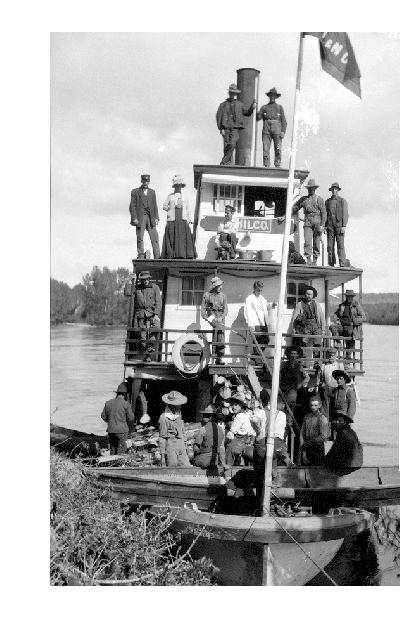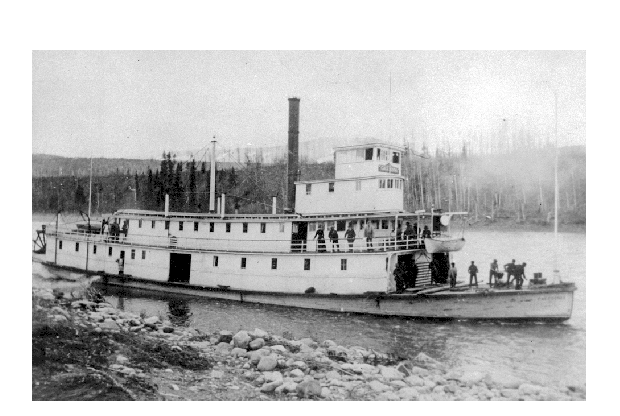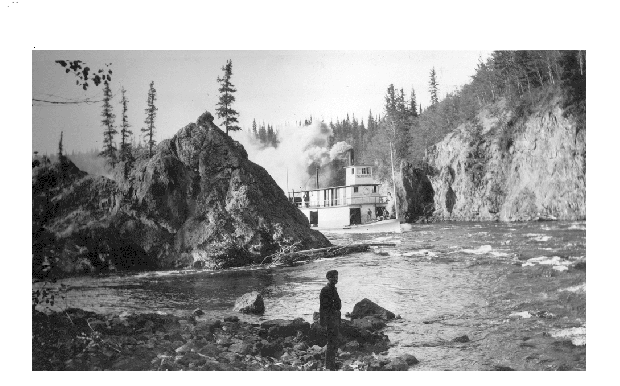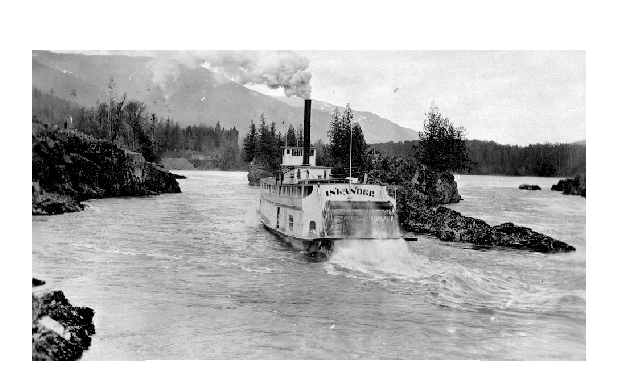
John Bonser (steamship captain)
Encyclopedia

Oregon
Oregon is a state in the Pacific Northwest region of the United States. It is located on the Pacific coast, with Washington to the north, California to the south, Nevada on the southeast and Idaho to the east. The Columbia and Snake rivers delineate much of Oregon's northern and eastern...
, USA and British Columbia
British Columbia
British Columbia is the westernmost of Canada's provinces and is known for its natural beauty, as reflected in its Latin motto, Splendor sine occasu . Its name was chosen by Queen Victoria in 1858...
, Canada
Canada
Canada is a North American country consisting of ten provinces and three territories. Located in the northern part of the continent, it extends from the Atlantic Ocean in the east to the Pacific Ocean in the west, and northward into the Arctic Ocean...
. He piloted dozens of sternwheelers
Paddle steamer
A paddle steamer is a steamship or riverboat, powered by a steam engine, using paddle wheels to propel it through the water. In antiquity, Paddle wheelers followed the development of poles, oars and sails, where the first uses were wheelers driven by animals or humans...
over his 40 year long career and pioneered many rivers in the Pacific Northwest
Pacific Northwest
The Pacific Northwest is a region in northwestern North America, bounded by the Pacific Ocean to the west and, loosely, by the Rocky Mountains on the east. Definitions of the region vary and there is no commonly agreed upon boundary, even among Pacific Northwesterners. A common concept of the...
.
John was born in 1855 at Sauvie Island
Sauvie Island
Sauvie Island, in the U.S. state of Oregon, originally Wapato Island or Wappatoo Island, is the largest island along the Columbia River, at 26,000 acres , and the largest river island in the United States...
near the banks of the Columbia River
Columbia River
The Columbia River is the largest river in the Pacific Northwest region of North America. The river rises in the Rocky Mountains of British Columbia, Canada, flows northwest and then south into the U.S. state of Washington, then turns west to form most of the border between Washington and the state...
in Oregon, the second son
of James Halstead Bonser. Riverboating was a tradition in the Bonser family, as both John's father and grandfather had been rivermen on the Scioto
Scioto River
The Scioto River is a river in central and southern Ohio more than 231 miles in length. It rises in Auglaize County in west central Ohio, flows through Columbus, Ohio, where it collects its largest tributary, the Olentangy River, and meets the Ohio River at Portsmouth...
and Ohio
Ohio River
The Ohio River is the largest tributary, by volume, of the Mississippi River. At the confluence, the Ohio is even bigger than the Mississippi and, thus, is hydrologically the main stream of the whole river system, including the Allegheny River further upstream...
rivers.
Oregon
In 1871, when John was 16, he and his older brother, Thomas Albert Bonser, left home and began working on riverboats on the CowlitzCowlitz River
The Cowlitz River is a river in the state of Washington in the United States, a tributary of the Columbia River. Its tributaries drain a large region including the slopes of Mount Rainier, Mount Adams, and Mount St. Helens....
, Lewis
Lewis River (Washington)
The Lewis River is a tributary of the Columbia River, about long, in southwestern Washington in the United States. It drains part of the Cascade Range north of the Columbia River. The drainage basin of the Lewis River covers about . The river's mean annual discharge is about . Unlike nearby Lewis...
and Columbia
Columbia River
The Columbia River is the largest river in the Pacific Northwest region of North America. The river rises in the Rocky Mountains of British Columbia, Canada, flows northwest and then south into the U.S. state of Washington, then turns west to form most of the border between Washington and the state...
rivers, doing everything from piloting the crafts to cooking in the galleys
Galley (kitchen)
The galley is the compartment of a ship, train or aircraft where food is cooked and prepared. It can also refer to a land based kitchen on a naval base or a particular formed household kitchen.-Ship's kitchen:...
.
Then in 1880, Albert drowned while working as a deckhand on the sternwheeler Latona. John considered quitting the river trade, but told his family that he would never let any river beat him.
For the next thirty-one years, he would keep that promise and would gain the reputation of being one of the best swift-water pilots in the business.
In 1881 John married Ida English and built a home in Woodland, Washington
Woodland, Washington
Woodland is a city in Clark and Cowlitz counties in the U.S. state of Washington. Most residents live within Cowlitz County, in which the majority of the city lies. It is part of the 'Longview, Washington Metropolitan Statistical Area'...
. On many occasions Ida would travel with John, even when their children, daughter, Viroqua, and son, Francisco, were born, the family would live on whatever sternwheeler John was piloting at the time. Ida would take the wheel if John was called away on an emergency and provided nursing care to sick or injured passengers and crew. When John began designing his own sternwheelers, he always made sure that a living quarters was built so that his family could accompany him.

Portland, Oregon
Portland is a city located in the Pacific Northwest, near the confluence of the Willamette and Columbia rivers in the U.S. state of Oregon. As of the 2010 Census, it had a population of 583,776, making it the 29th most populous city in the United States...
, and provided important transportation and delivery services for the settlements along the river.
British Columbia

Fraser River
The Fraser River is the longest river within British Columbia, Canada, rising at Fraser Pass near Mount Robson in the Rocky Mountains and flowing for , into the Strait of Georgia at the city of Vancouver. It is the tenth longest river in Canada...
captain, who was currently employed by the Hudson's Bay Company
Hudson's Bay Company
The Hudson's Bay Company , abbreviated HBC, or "The Bay" is the oldest commercial corporation in North America and one of the oldest in the world. A fur trading business for much of its existence, today Hudson's Bay Company owns and operates retail stores throughout Canada...
to navigate a route on the Skeena River
Skeena River
The Skeena River is the second longest river entirely within British Columbia, Canada . The Skeena is an important transportation artery, particularly for the Tsimshian and the Gitxsan - whose names mean "inside the Skeena River" and "people of the Skeena River" respectively, and also during the...
from Port Essington
Port Essington, British Columbia
Port Essington was a cannery town on the south bank of the Skeena River estuary in northwestern British Columbia, Canada, between Prince Rupert and Terrace, and at the confluence of the Skeena and Ecstall Rivers. It was founded in 1871 by Robert Cunningham and Thomas Hankin and was for a time...
to Hazelton
Hazelton, British Columbia
Hazelton is a small town located at the junction of the Bulkley and Skeena Rivers in northern British Columbia, Canada. It was founded in 1866 and has a population of 293...
. Several attempts had been made by other pilots to navigate the treacherously swift Skeena River but none had been successful. Part of Odin's letter read, "We understand that you have the reputation of not being afraid to take a steamboat over Niagara Falls
Niagara Falls
The Niagara Falls, located on the Niagara River draining Lake Erie into Lake Ontario, is the collective name for the Horseshoe Falls and the adjacent American Falls along with the comparatively small Bridal Veil Falls, which combined form the highest flow rate of any waterfalls in the world and has...
, across the Sahara Desert or from hell to
breakfast. We've got the boat here and we want a man to take it into the mountains. If you think you can do it the job is yours."
The boat in question was the Caledonia. Bonser took the job and he and his family moved to British Columbia, building a home in Vancouver.
The Caledonia was considered a success and began serving not only the Skeena River, but also the northern coastal regions. In 1895, the Caledonia was overhauled and lengthened at Bonser's request, making her more maneuverable. Bonser named eleven of the canyons and rapids on the Skeena River, using the character of the obstacle as a guide. Among them were the Whirly Gig Rapids, Hornet’s Nest Rapids and the Devil’s Elbow Canyon where the Skeena rushed directly towards a rock bluff before twisting off to the right. Despite these perils the Caledonia operated for seven seasons.
By 1898, the Klondike Gold Rush
Klondike Gold Rush
The Klondike Gold Rush, also called the Yukon Gold Rush, the Alaska Gold Rush and the Last Great Gold Rush, was an attempt by an estimated 100,000 people to travel to the Klondike region the Yukon in north-western Canada between 1897 and 1899 in the hope of successfully prospecting for gold...
was in full swing and there was more interest in the north than ever previously. A business rival of the Hudson's Bay Company, Robert Cunningham, bought the Monte Cristo and hired Captain Bonser away from the HBC to pilot it.
Then in 1900, Cunningham sent Bonser down to Victoria to design a sternwheeler specifically for the Skeena River. This would become the Hazelton
Hazelton (sternwheeler)
The Hazelton was a sternwheeler that worked on the Skeena River in British Columbia, Canada from 1901 until 1912. Her first owner was Robert Cunningham who ran a freighting business that served the communities along the Skeena River....
and under Bonser’s command she soon proved to be superior to all the other boats on the river. In her first season, she went to Hazelton thirteen times, making the trip upstream in forty hours and downstream in ten. Realizing that the new HBC sternwheeler Strathcona and the Caledonia could not compete, the HBC built a third sternwheeler, the Mount Royal
Mount Royal (sternwheeler)
The Mount Royal was a sternwheeler that worked on the Skeena River and Stikine Rivers in British Columbia, Canada, from 1902 until 1907. She was named after Lord Strathcona who was also known as Donald Smith, 1st Baron Strathcona and Mount Royal....
and hired Captain Johnson as her pilot.
Sternwheeler race on the Skeena River

In the spring of 1904, both boats wanted to be the first one of the season to arrive in Hazelton. Captain Bonser started out in the Hazelton first, and while he was wooding-up 105 miles upstream, he saw the Mount Royal with Johnson at the helm coming up from behind.

The HBC and Robert Cunningham came to a mutual decision that the rivalry was not profitable and an agreement was reached to end it. Cunningham tied up his vessel, and the HBC hauled his freight for free. Later, the HBC bought the Hazelton. The new arrangements between the HBC and Robert Cunningham left Captain Bonser without a vessel until 1906 when he took command of the Pheasant, a small sternwheeler that was the butt of many jokes and nicknamed the "Chicken" because it had to scratch so hard to get upstream. She was wrecked that autumn in the Redrock Canyon, the first loss of Bonser’s long career, although not his last. Bonser’s next boat was the Northwest, which was owned by the Northern British Columbia Transportation Company, a company which also had a hotel and store at Telkwa
Telkwa, British Columbia
Telkwa is a village located along British Columbia Highway 16, nearly 15 km southeast of the town of Smithers and 350 km west of the city of Prince George, in northwest British Columbia, Canada....
. The Northwest's main purpose was to deliver liquor from the coast to hotels along the Skeena.
In September 1907, the Northwest was lost, when she hit a rock and sank. There was no loss of life, but she was carrying the winter liquor supply for the towns along the Skeena, and her loss still caused a bit of uproar. In response to this minor crisis, the HBC refitted the Caledonia and she ran an emergency trip up the Skeena with the much desired supplies.
Bonser then moved on to the upper Fraser River in 1909, where he would pilot two sternwheelers before returning to the Skeena in 1911.
Upper Fraser River

South Fort George
South Fort George is a suburb of Prince George, British Columbia, Canada.Before the arrival of the Grand Trunk Pacific Railway in 1914, the Prince George area was known as Fort George and was a Lheidli T'enneh village and Hudson's Bay Company store....
to pilot the Nechacco
Nechacco (sternwheeler)
The Nechacco sternwheeler was built for service on the Soda Creek to Fort George route on the upper Fraser River in British Columbia. She was owned by the Fort George Lumber and Navigation Company. The partners in this company were Nick Clark and Russel Peden of South Fort George, who operated a...
, which would later be renamed the Chilco. Under his command the Nechacco would be the first sternwheeler to navigate the treacherous Grand Canyon of the Fraser
Grand Canyon of the Fraser
thumb|right|250px|Scow at Grand CanyonThe Grand Canyon of the Fraser is a short gorge on the Fraser River in north-central British Columbia about 30km upstream from the confluence of the Bowron River and about 100km due east of downtown Prince George, British Columbia...
.
_near_nechako_river.jpg)
Fort Fraser (sternwheeler)
The Fort Fraser was a small sternwheeler owned by the Fort George Lumber and Transportation Company a partnership originally held by Nick Clarke and Russell Peden from the Fort George town-site of South Fort George...
in which Bonser pioneered the route to Tête Jaune Cache in 1910.
Both sternwheelers would often be chartered by pioneer surveyor
Hydrographic survey
Hydrographic survey is the science of measurement and description of features which affect maritime navigation, marine construction, dredging, offshore oil exploration/drilling and related disciplines. Strong emphasis is placed on soundings, shorelines, tides, currents, sea floor and submerged...
Frank Swannell
Frank Swannell
Frank Cyril Swannell was one of British Columbia's most famous surveyors.He came to British Columbia during the era of the Klondike Gold Rush and became a surveyor's assistant. Then, from 1908, he was a professional surveyor and surveyed many regions of British Columbia...
who traveled on them to areas he was surveying in the Nechako Valley along the Stuart
Stuart River
The Stuart River is a river in northeastern British Columbia, Canada. The river flows over from Stuart Lake to its junction with the Nechako River. The river drains a portion of the Nechako Plateau — a gently-rolling region characterized by small lakes and tributaries...
and Nechako rivers.
The Inlander

Grand Trunk Pacific Railway
The Grand Trunk Pacific Railway was a historical Canadian railway.A wholly owned subsidiary of the Grand Trunk Railway , the GTPR was constructed by GTR using loans provided by the Government of Canada. The company was formed in 1903 with a mandate to build west from Winnipeg, Manitoba to the...
line was finished to from Prince Rupert
Prince Rupert, British Columbia
Prince Rupert is a port city in the province of British Columbia, Canada. It is the land, air, and water transportation hub of British Columbia's North Coast, and home to some 12,815 people .-History:...
to Hazelton, a death knell for the local sternwheelers. On September 13, 1912 the Inlander left Hazelton for the final time, the last of the sternwheelers on the Skeena River. When she reached Port Essington, the Inlander was pulled up onto ways and left to rot.
Captain Bonser died just over a year later, on December 26, 1913 at Providence St. Vincent Medical Center
Providence St. Vincent Medical Center
Providence St. Vincent Medical Center, is a non-profit, acute care hospital in the Portland metropolitan area of the U.S. state of Oregon. The center is Providence Health & Services’s largest Oregon hospital. St...
in Portland. He was buried next to his son, Francisco, at the Deer Island Cemetery near Goble, Oregon
Goble, Oregon
Goble is an unincorporated community in Columbia County, Oregon, United States. It is located on U.S. Route 30 and the Columbia River.-History:The Goble area was most likely a stop for the Lewis and Clark Expedition....
.

